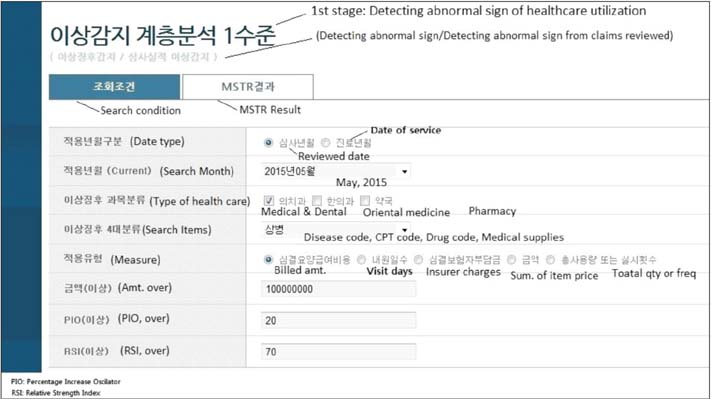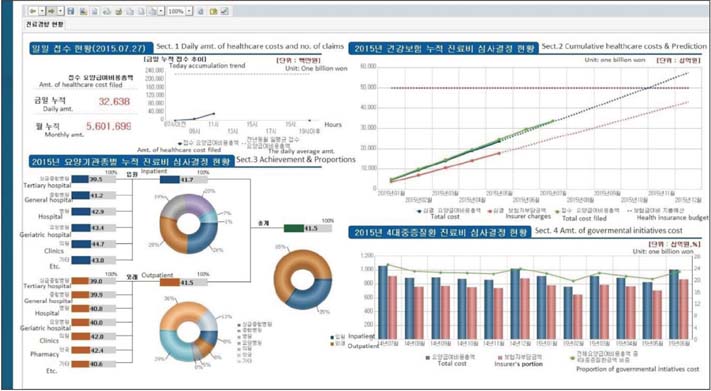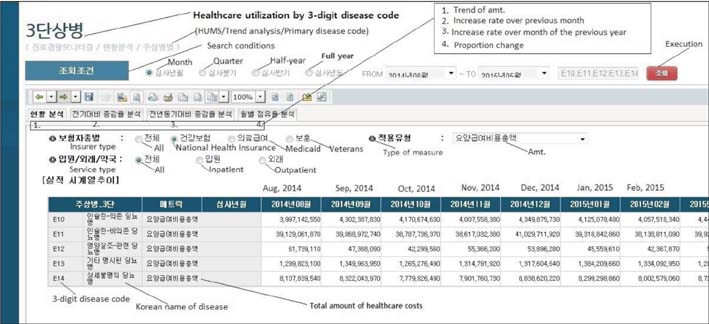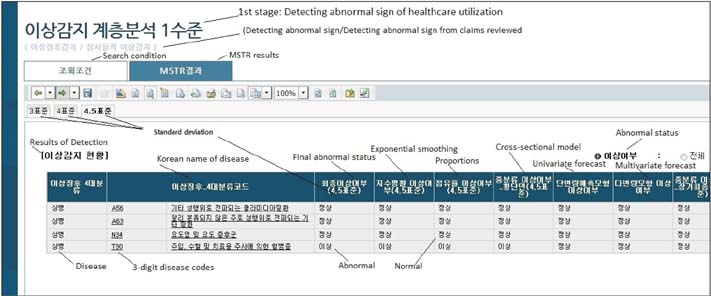Healthc Inform Res.
2015 Jul;21(3):184-190. 10.4258/hir.2015.21.3.184.
Healthcare Utilization Monitoring System in Korea
- Affiliations
-
- 1Research Institute for Health Insurance Review & Assessment, Health Insurance Review & Assessment Service (HIRA), Seoul, Korea. pyt0601@hiramail.net
- 2Ministry of Health, Wellington, New Zealand.
- KMID: 2125187
- DOI: http://doi.org/10.4258/hir.2015.21.3.184
Abstract
OBJECTIVES
It is important to monitor the healthcare utilization of patients at the national level to make evidence-based policy decisions and manage the nation's healthcare sector. The Health Insurance Review & Assessment Service (HIRA) has run a Healthcare Utilization Monitoring System (HUMS) since 2008. The objective of this paper is to introduce HIRA's HUMS.
METHODS
This study described the HUMS's system structure, capacity, functionalities, and output formats run by HIRA in the Republic of Korea. Regarding output formats, this study extracted diabetes related health insurance claims through the HUMS from August 1, 2014 to May 31, 2015.
RESULTS
The HUMS has kept records of health insurance claim data for 4 years. It has a 14-terabyte hardware capacity and employs several easy-to-use programs for maintenance of the system, such as MSTR, SAS, etc. Regarding functionalities, users should input diseases codes, target periods, facility types, and types of attributes, such as the number of healthcare utilizations or healthcare costs. It also has a functionality to predict healthcare utilization and costs. When this study extracted diabetes related data, it was found that the trend of healthcare costs for the treatment of diabetes and the number of patients with diabetes were increasing.
CONCLUSIONS
HIRA's HUMS works well to monitor healthcare utilization of patients at the national level. The HUMS has a high-capacity hardware infrastructure and several operational programs that allows easy access to summaries as well as details to identify contributing factors for abnormality, but it has a limitation in that there is often a time lag between the provision of healthcare to patients and the filing of health claims.
MeSH Terms
Figure
Cited by 1 articles
-
Constructing a Real-Time Prescription Drug Monitoring System
Young-Taek Park, Youn Tae Lee, Emmanuel C. Jo
Healthc Inform Res. 2016;22(3):178-185. doi: 10.4258/hir.2016.22.3.178.
Reference
-
1. Milinovich GJ, Williams GM, Clements AC, Hu W. Internet-based surveillance systems for monitoring emerging infectious diseases. Lancet Infect Dis. 2014; 14(2):160–168.
Article2. Gale A, Jun K. Korea's MERS outbreak highlights SARS lessons [Internet]. New York (NY): The Wall Street Journal;2015. cited at 2015 Jul 15. Available from: http://www.wsj.com/articles/mers-outbreak-lax-quarantines-hurt-south-korea-1433832955.3. Park YT, Yoon JS, Speedie SM, Yoon H, Lee J. Health insurance claim review using information technologies. Healthc Inform Res. 2012; 18(3):215–224.
Article4. Shin HC. Healthcare utilization monitoring system: user guidance manual. Seoul, Korea: Health Insurance Review & Assessment Service;2015.5. Rotondi NK, Rush B. Monitoring utilization of a large scale addiction treatment system: the Drug and Alcohol Treatment Information System (DATIS). Subst Abuse. 2012; 6:73–84.
Article6. Coloma PM, Schuemie MJ, Trifiro G, Gini R, Herings R, Hippisley-Cox J, et al. Combining electronic healthcare databases in Europe to allow for large-scale drug safety monitoring: the EU-ADR Project. Pharmacoepidemiol Drug Saf. 2011; 20(1):1–11.
Article7. Ontario Ministry of Health and Long-Term Care. Narcotics Monitoring System (NMS): pharmacy reference manual. Toronto, Canada: Ontario Ministry of Health and Long-Term Care;2012.8. Clark T, Eadie J, Kreiner P, Strickler G. Prescription drug monitoring programs: an assessment of the evidence for best practice [Internet]. Philadelphia (PA): The Pew Charitable Trusts;2012. cited at 2015 Jul 15. Available from: http://www.pewtrusts.org/~/media/Assets/0001/PDMP_Update_1312013.pdf.9. Ortiz E, Clancy CM. AHRQ. Use of information technology to improve the quality of health care in the United States. Health Serv Res. 2003; 38(2):xi–xxii.
Article10. Park YT. HIRA's health insurance claim data and use of information and communication technology. HIRA Policy Trends. 2013; 7(6):42–51.11. Buntin MB, Burke MF, Hoaglin MC, Blumenthal D. The benefits of health information technology: a review of the recent literature shows predominantly positive results. Health Aff (Millwood). 2011; 30(3):464–471.
Article
- Full Text Links
- Actions
-
Cited
- CITED
-
- Close
- Share
- Similar articles
-
- The Effects of Case Management for Medicaid on Healthcare Utilization by the Medicaid System
- Utilization of Automated Notification System of Epidemic Based on Clinical Microbiological Test Results
- Exploring the Perception on Drug Utilization Review System and DUR Modernization Pilot Project: A Qualitative Study Using Focus Group Interviews
- Constructing a Real-Time Prescription Drug Monitoring System
- Healthcare System Needs to be Reinforced toward the Environmental Changes








